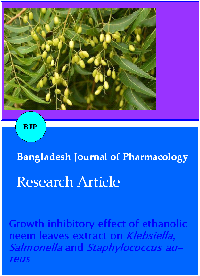Growth inhibitory effect of ethanolic neem leaves extract on Klebsiella, Salmonella and Staphylococcus aureus
DOI:
https://doi.org/10.3329/bjp.v9i3.19454Keywords:
Azadirachta indica, Klebsiella, Salmonella, Staphylococcus aureus, Minimum inhibitory concentration (MIC)Abstract
Neem (leaves, flowers, seeds etc.) have been used traditionally against many diseases. We, thus, investigated the antimicrobial effect of ethanolic neem leave extract on Klebsiella, Salmonella and Staphylococcus aureus and found its growth inhibitory effect on Klebsiella and Salmonella at the concentration of 12.5 mg/mL and 6.2 mg/mL respectively with average diameter of zone of inhibition 18 mm and 20 mm respectively. It failed to inhibit the growth of Staphylococcus aureus at the highest concentration used (50 mg/mL). Findings of this preliminary experimental study suggest that, neem can be tried against Klebsiella and Salmonella showing limited efficacy.
Downloads
913
393 Read
280
References
Chaturvedi P, Bag A, Rawat V, Jyala NS, Satyavali V, Jha PK. Antibacterial effects of Azadirachta indica leaf and bark extracts in clinical isolates of diabetic patients. NJIRM. 2011; 2: 5-9.
Cosgrove SE and Carmeli Y. The impact of antimicrobial resistance on health and economic outcomes. Clinical Inf Dis. 2003; 36: 1433-37.
Faiz MA, Basher A. Antimicrobial resistance: Bangladesh experience. Regional Health Forum. 2011; 15: 1-8.
Girish K, Shankara Bhat S. Neem: A green treasure. Electronic J of Biol. 2008; 4: 102-11.
Mamman PH, Mshelia WP, Susbatrus SC, Sambo KW. Antibacterial effects of crude extract of Azadirachta indica against Escherichia coli, Salmonella spp and Staphylococcus aureus. Int J Med Med Sci. 2013; 5: 14-18.
Helmy WA, Amer H, EL-Shayeb NMA. Biological and anti-microbial activities of aqueous extracts from neem tree (Azadirachta indica A Juss, Meliaceae). J Appl Sci Res. 2007; 3: 1050-55.
Hudzicki J. Kirby-Bauer disk diffusion susceptibility test protocol. MicrobeLibrary.org. 2009.
Huttner A, Harbarth S, Carlet J, Cosgrove S, Goossens H, Holmes A, Jarlier V, Voss A, Pittet D. Antimicrobial resistance: A global view from the 2013 World Healthcare-Associated Infections Forum. Antimicrobial Res Inf Cont. 2013; 2: 31.
Irshad S, Butt M, Younus H. In-vitro antibacterial activity of two medicinal plants neem (Azadirachta indica) and peppermint. Int R J Pharmaceut. 2011; 1: 9-14.
Jahan T, Begum ZA, Sultana S. Effect of neem oil on some pathogenic bacteria. Bangladesh J Pharmacol.2007; 2: 71-72.
Karmakar P, Sattar MM. Antibiotic prescribing pattern in Bangladesh. B J Prog Sci Tech. 2012; 10: 13-16.
Khan I, Srikakolupu SR, Darsipudi S, Gotteti SD, Amaranadh CH. Phytochemical studies and screening of leaf extracts of
Azadirachta indica for its anti-microbial activity against dental pathogens. Archives of App Sci Res. 2010; 2: 246-50.
Kumar BU, Bhubaneswari A, Tejasri MVV, Radhakrishna P and Amritha KDK. Comparative antimicrobial activities of the combined crude leaf extract of Bixa Orellana, Azadirachta indica and Ocimumscantum. Int Res J Pharm. 2013; 4(4): 189-93.
Maragathavalli S, Brindha S, Kaviyarasi NS, B. Annadurai B, Gangwar SK. Antimicrobial activity in leaf extract of neem (Azadirachta indica Linn.). IJSN. 2012; 3: 110-13.
Mosaddek ASM, Rshid MMU. A comparative study of the anti-inflammatory effect of aqueous extract of neem leaf and dexamethasone. Bangladesh J Pharmacol. 2008; 3: 44-47.
Mishra A, Mamta, Neema, Niketa, Poonam, Pranjul and Priyanka. Antibacterial effects of crude extract of Azadirachta indica against Escherichia coli and Staphylococcus aureus. Int J Sci Environ Tech. 2013; 2: 989-93.
Odunbaku OA, Ilusanya OA. Antibacterial activity of the ethanolic and methanolic leaf extracts of some tropical plants on some human pathogenic microbes. Res J Agric Biol Sci. 2008; 4: 373-76.
Prashar P, Pruthi H, Akhlaq A. In vitro antimicrobial activity of Azadirachta indica against pathogenic bacteria. J Pharm Res. 2012; 5: 363-64.
Rahman MS, Huda S. Antimicrobial resistance and related issues: An overview of Bangladesh situation. Bangladesh J Pharmacol. 2014; 9: 218-24.
Rajasekaran C, Meignanam E, Vijayakumar V, Kalaivani T, Ramya S, Premkumar N, Siva R, Jayakumararaj R. Investigations on antibacterial activity of leaf extracts of Azadirachta indica A. Juss (Meliaceae): A traditional medicinal plant of India. Ethnobotanical Leaflets. 2008; 12: 1213-17.
Reardon S. Antibiotic resistance sweeping developing world. Nature 2014; 509: 141-42.
Reddy YRR, Kumari CK, Lokanatha O, Mamatha S, Reddy CD. Antimicrobial activity of Azadirachta indica (neem) leaf, bark and seed extracts. Int J Phytochem Pharmacol. 2013; 3: 1-4.
Rozarina NJA. Antimicrobial potentials of the methanolic extracts of plants. IJSRR. 2013; 2: 89-95.
Sarmiento WC, Maramba CC, Gonzales MLM. An in vitro study on the antibacterial effect of neem (Azadirachta indica) leaf extract on methicillin-sensitive and methicillin-resistant Staphylococcus aureus. PIDSP J. 2011; 12: 40-45.
Shamsuzzaman AKM, Paul SK, Mahmud MC, Musa AKM, Hossain MA. Emerging antimicrobial resistance amongst common bacterial pathogens in Mymensingh Medical College Hospital. Bangladesh J Med Microbiol 2007; 1: 4-9.
Victor IU, Igeleke CL. Antimicrobial properties of the extracts of locally sold garlic and neem leaf in Benin City, Nigeria. Int J Biosci. 2012; 2: 21-27.
WHO. Antimicrobial resistance: Global report on surveillance 2014.
Yerima MB, Jodi SM, Oyinbo K, Maishanu HM, Farouq AA, Junaidu AU, Al-Mustapha MN, Shinkafi AL. Effect of neem extracts (Azadirachta indica) on bacteria isolated from adult mouth. Nigerian J Basic App Sci. 2012; 20: 64-67.

Additional Files
Published
How to Cite
Issue
Section
License
Authors who publish with this journal agree to the following terms:
- Authors retain copyright and grant the journal right of first publication with the work simultaneously licensed under a Creative Commons Attribution License that allows others to share the work with an acknowledgement of the work's authorship and initial publication in this journal.
- Authors are able to enter into separate, additional contractual arrangements for the non-exclusive distribution of the journal's published version of the work (e.g., post it to an institutional repository or publish it in a book), with an acknowledgement of its initial publication in this journal.
- Authors are permitted and encouraged to post their work online (e.g., in institutional repositories or on their website) prior to and during the submission process, as it can lead to productive exchanges, as well as earlier and greater citation of published work (See The Effect of Open Access).
